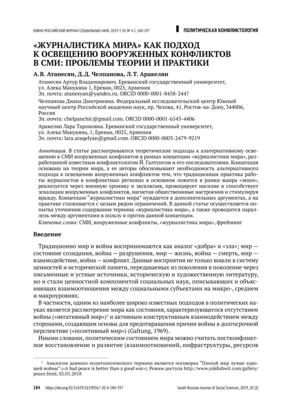Abstract
Alternative approach to cover armed conflicts in Mass Media developed in frames of “Peace journalism” by Johan Galtung and his followers, is discussed in this paper. The concept itself is based on Peace Studies, and justified by the precondition that traditional Media framing of armed conflicts based on sensations, search for exclusive materials, and demonstration of battlefield with visualization of violence, used to be provocative and might contribute to further escalation of a conflict through cultivation of enmity in the societies involved. This is the main reason why the common approach to Media coverage of armed conflicts in frames of “action” is proposed to be replaced by “Peace journalism”, which also needs to be clarified as a concept, within its specific as well as common techniques. The concept of “Peace journalism” itself still needs additional argumentation, and often meets various limits of technical as well as conceptual nature. In the paper an attempt to clarify the content of “Peace journalism” as well as to illustrate the pros and contras of the concept, is presented.
Keywords
References
- Atanesyan A. V. (2019). “Barkhatnaya revolyuciya” v Armenii: potencial, dostizheniya i riski politikoprotestnoy aktivnosti [“Velvet Revolution” in Armenia: Potential, Gains and Risks of Political Protest Activity]. POLIS. Politicheskiye issledovaniya [Polis. Political Studies], 6, 80–98.
- Brüggemann, M. (2014). Between Frame Setting and Frame Sending: How Journalists Contribute to News Frames. Communication Theory, 24(1), 61–82. DOI: 10.1111/comt.12027
- Dijkzeul, D. (2008). Towards a Framework for the Study of “No War, No Peace” Societies. Working Paper 2, Swiss Peace, April.
- Dimitrova, D. V., Strömbäck, J. (2008). Foreign Policy and the Framing of the 2003 Iraq War in Elite Swedish and US Newspapers. Media, War & Conflict, 1(2), 203–220. DOI: 10.1177/1750635208090957
- Entman, R. M. (2003). Cascading Activation: Contesting the White House’s Frame After 9/11. Political Communication, 20, 415–432. DOI: 10.1080/10584600390244176
- Evans, M. (2010). Framing International Conflicts: Media Coverage of Fighting in the Middle East. International Journal of Media and Cultural Politics, 6(2), 209–233. DOI: 10.1386/mcp.6.2.209_1
- Galtung, J. (1969). Violence, Peace and Peace Research. Journal of Peace Research, 6(3), 167–191.
- Gerasimovich, O. P. (2014). Konfliktologiya zhurnalistiki [Conflict Studies of Journnalism]. Minsk: BGU.
- Gerbner, G., Gross, L., Morgan, M., Signorielli, N. (1986). Living with Television: The Dynamics of the Cultivation Process. In J. Bryant and D. Zillmann (Eds.). Perspectives on Media Effects (pp. 17–40). Lawrence Erlbaum Associates, Hillsdale, N.J.
- Hallahan, K. (1999). Seven Models of Framing: Implications for Public Relations. Journal of Public Relations Research, 11(3), 205–242.
- Irvan, S. (2006). Peace Journalism as a Normative Theory: Premises and Obstacles. GMJ: Mediterranean Edition, 1(2), 34–39.
- Konovalenko, M. Yu., Konovalenko, V. A. (2016). Teoriya kommunikacii: uchebnik dlya akademicheskogo bakalavriata [Communication Theory: A Textbook for an Academic Undergraduate Level]. M.: Izdatel'stvo Yurayt.
- Laplante, L. J., Phenicie, K. (2009). Mediating Post-Conflict Dialogue: The Media’s Role in Transitional Justice Processes. Marquette Law Review, 93(1), 251–283.
- Lederach, J. P. (1998). Building Peace. Sustainable Reconciliation in Divided Societies. Washington, D.C.: United States Institute of Peace Press.
- Lynch, J. (2015). Peace journalism: Theoretical and methodological developments. Global Media and Communication, 11(3), 193–199. DOI: 10.1177/1742766515606297
- Matthes, F. (2008). Need for Orientation as a Predictor of Agenda-Setting Effects: Causal Evidence from a Two-Wave Panel Study. International Journal of Public Opinion Research, 20(4), 440–453. DOI:10.1093/ijpor/edn042
- McCombs, M. E., Shaw, D. L., Weaver, D. H. (2014). New Directions in Agenda-Setting Theory and Research. Mass Communication and Society, 17(6), 781–802. DOI: 10.1080/15205436.2014.964871
- McGoldrick, A., Lynch, J. (2000). Peace Journalism: What is it? How to do it? Reporting the World. Retrieved from https://www.transcend.org/tri/downloads/McGoldrick_Lynch_Peace-Journalism.pdf
- Melezhik, K. A. (2016). Interpretaciya smysla v mezhnacional'noy kommunikacii na angliyskom yazyke [Interpretation of Meaning in Transnational Communication in Lingua Franca English]. Rossiyskiy gumanitarnyy zhurnal [Liberal Arts in Russia], 5(4), 394–402.
- Mogekwu, M. (2011). Conflict Reporting and Peace Journalism: in Search of a New Model. Lessons from the Nigerian NigerDelta Crisis. In I. S. Shaw, J. Lynch, and R. A. Hackett (Ed.) Expanding Peace Journalism: Comparative and Critical Approaches (pp. 239–260). Sydney University Press.
- Moy, P., Tewksbury, D., Rinke, E.M. (2016). Agenda-Setting, Priming, and Framing. In J. K. Bruhn and R. T. Craig (Ed.). The International Encyclopedia of Communication Theory and Philosophy (pp. 1–13). John Wiley & Sons, Inc. DOI: 10.1002/9781118766804.wbiect266
- Olejnikov, S. V. (2015). Mirotvorcheskiy potencial i yazyk konflikta sovremennoy zhurnalistiki [Modern Journalism: Peacemaking Potential and Language of Conflict]. Vestnik SPbGU [Vestnik SPbSU], 9(2), 208–215.
- Orgeret, K. S. (2016). Conflict and Post-Conflict Journalism Worldwide Perspectives. In K. S. Orgeret and W. Tayeebwa (Eds.) Journalism in Conflict and Post-Conflict Conditions Worldwide Perspectives. University of Gothenburg, Nordicom.
- Puddephatt, А. (2006). Voices of war: Conflict and the role of the media. International Media Support. Retrieved from https://www.mediasupport.org/wp-content/uploads/2012/11/ims-voices-of-war-2006.pdf
- Scheufele, D. A. & Tewksbury, D. (2007). Framing, Agenda Setting, and Priming: The Evolution of Three Media Effects Models. Journal of Communication, 57, 9–20.
- Scheufele, D. A. (1999). Framing as a Theory of Media Effects. Journal of Communication, 49(1), 103–122. DOI: 10.1111/j.1460–2466.1999.tb02784.x
- Shinar, D. (2007). Independent Media and Peace Journalism. In S. Celenk (Ed.) Another Communication is Possible (pp. 179–185). İstanbul: IPS Foundation. Retrieved from http://bianet.org/system/uploads/1/files/attachments/000/001/522/original/Another_communication_is_possible.pdf?1447151794
- Somerville, K. (2017). Framing Conflict — the Cold War and after: Reflections from an Old Hack. Media, War & Conflict, 10(1), 48–58. DOI: 10.1177/1750635217698336
- Yakova, T. S. (2018). “Mirnaya zhurnalistika” v protivodeystvii terrorizmu [“Peaceful Journalism” in Countering Terrorism]. Elektronnyy nauchnyy zhurnal “Mediaskop” [Online Academic Journal “Mediascope”], 3. Retrieved from http://www.mediascope.ru/2477
- Yang Lai Fong, N. (2009). Framing Analysis of a Conflict: War / Peace Journalism. SEARCH: The Journal of the South East Asia Research Centre for Communications and Humanities, 1(1), 17–32.
 Русский
Русский


